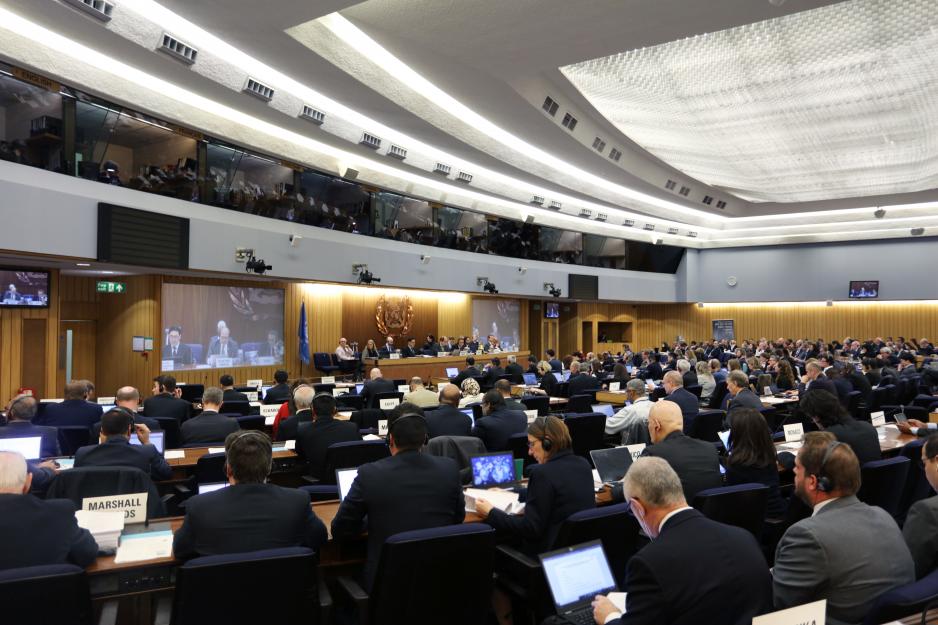IMO Moves Forward with Ban of Arctic HFO But Exempts Some Vessels Until 2029

IMO’s Sub-Committee on Pollution Prevention and Response (PPR 7) February 17-19, 2020. (Source: Courtesy of the IMO under CC BY 2.0)
The IMO agreed on a draft regulation which would phase out the use and carriage of HFO in the Arctic starting in 2024. Environmental groups criticize loopholes which delay the ban until 2029 for Arctic-flagged vessels.
The International Maritime Organization (IMO) and its member states have been inching towards a ban of Heavy Fuel Oil (HFO) in the Arctic for almost a decade. Last week its Sub-Committee on Pollution Prevention and Response (PPR7) agreed on a draft text which proposes a ban on the use and carriage of HFO by the middle of 2024.
Heavy Fuel Oil is the dirtiest type of marine fuel and poses grave risk to the region’s marine environment in case of accidental spill. It has been banned in the waters surrounding Antarctica for almost a decade.
Earlier in the week Canada had announced that it would end its opposition to banning HFO, leaving Russia as the sole holdout among Arctic states. The draft regulation permits Arctic states to waive the ban for ships flying their own flag while traveling in their domestic waters until July 1, 2029, a crucial concession in order to secure Russia’s support.
Exemption for Russia’s NSR
The exemption effectively means that Russian-flagged vessels traveling along the country’s Northern Sea Route (NSR), will be exempt from the ban for nearly another decade. Arctic shipping has been growing most rapidly along the NSR with shipping volume growing ten-fold over the past decade. While environmental organizations commended the IMO’s efforts in moving forward with the ban, they harshly criticized “the inclusion of loopholes” which expose the Arctic to the growing threat from HFO for almost another decade.
“While the IMO has made some progress this week on controlling heavy fuel oil use and carriage as fuel in the Arctic, it is outrageous that Member States are prepared to accept another decade of threats from HFO spills to Arctic communities, the environment and wildlife,” said Dr Sian Prior, Lead Advisor to the Clean Arctic Alliance, a coalition of 18 non-governmental organizations.
Representatives of indigenous communities also criticized the proposed ban as insufficient. “We will continue advocating for a full ban to protect our Indigenous communities and our environment,” said Lisa Koperqualuk, Vice-President of Inuit Circumpolar Council Canada.
A ban with many loopholes
The draft regulation, which now moves forward for consideration by the Marine Environment Protection Committee in October 2020 (MEPC 76), allows for the continued use of HFO until July 1, 2024. At that point two loopholes permit the continued use of HFO for some vessels. Countries can exempt their own vessels within their domestic waters. Furthermore, all double-hulled vessels – ships that have two layers of watertight hull – are also exempt from the ban until the middle of 2029.
In combination, these waivers severely weaken the proposed ban environmental groups say. Russia’s Arctic waters are home to rapidly growing bulk and cargo shipments related to its natural gas projects, including Yamal LNG. The vast majority of vessels on the NSR fly the Russian flag and will thus be exempt from the ban until 2029. In 2019, out of 799 vessels applying for a NSR permit, 682 ships flew the country’s flag, a full 85 percent.
As older single-hulled ships are replaced with newer double-hulled ships – exempt from the ban until 2029 – the number of ships carrying and using HFO will actually increase over the coming decade despite the now-proposed IMO regulation.
More action will be needed
Environmental groups stress that the proposed regulation does not go nearly far enough and does not offer any additional protection for Arctic waters until 2024. With the rapid growth of shipping in the Arctic, the use of HFO will continue to grow rapidly until 2024. The fuel already represents the most-consumed marine fuel in the region accounting for almost 60 percent of all fuels. In total ships traveling throughout the Arctic carried more than 830,000 tons of HFO on board in 2015, more than twice the figure of 2012.
The IMO efforts related to the Arctic have received close scrutiny by environmental advocates. In addition to the ban of HFO, the IMO faces calls for a reduction of black carbon emissions in the Arctic. A recent study revealed that the organization’s new rule requiring the use of very low sulphur fuel oil can unexpectedly result in high levels of black carbon – a pollutant especially harmful to the Arctic environment.

